Abstract
The authors report a clinical trial designed to compare the discomfort produced by plain and epinephrine-containing lidocaine solutions during local anesthesia in the maxilla. Twenty-four healthy volunteers were recruited; each received buccal and palatal infiltrations on each side of the maxilla in the premolar region. The solutions were 2% lidocaine and 2% lidocaine with 1:80,000 epinephrine. Allocation to side was randomized and operator and volunteer were blinded to the identity of the solutions. Volunteers recorded injection discomfort on a 100-mm visual analogue scale (VAS). Volunteers were included in the trial if a score of at least 30 mm was recorded for at least 1 of the matched pair of injections. Differences between treatments were measured using Student's paired t test. Twelve volunteers recorded a VAS score of at least 30 mm for 1 or both buccal injections, and 17 volunteers reached this score for palatal injections. Buccal injection pain was less when the plain solution was used (P = .04) and was not influenced by the order of the injection. Palatal injection discomfort did not differ between the solutions; however, the second palatal injection was more uncomfortable than the first palatal injection (P = .046). These results suggest that plain lidocaine produces less discomfort than lidocaine with epinephrine when administered into the maxillary premolar buccal sulcus in individuals who report moderate pain during this injection. Palatal injection discomfort does not differ between these solutions.
Full text
PDF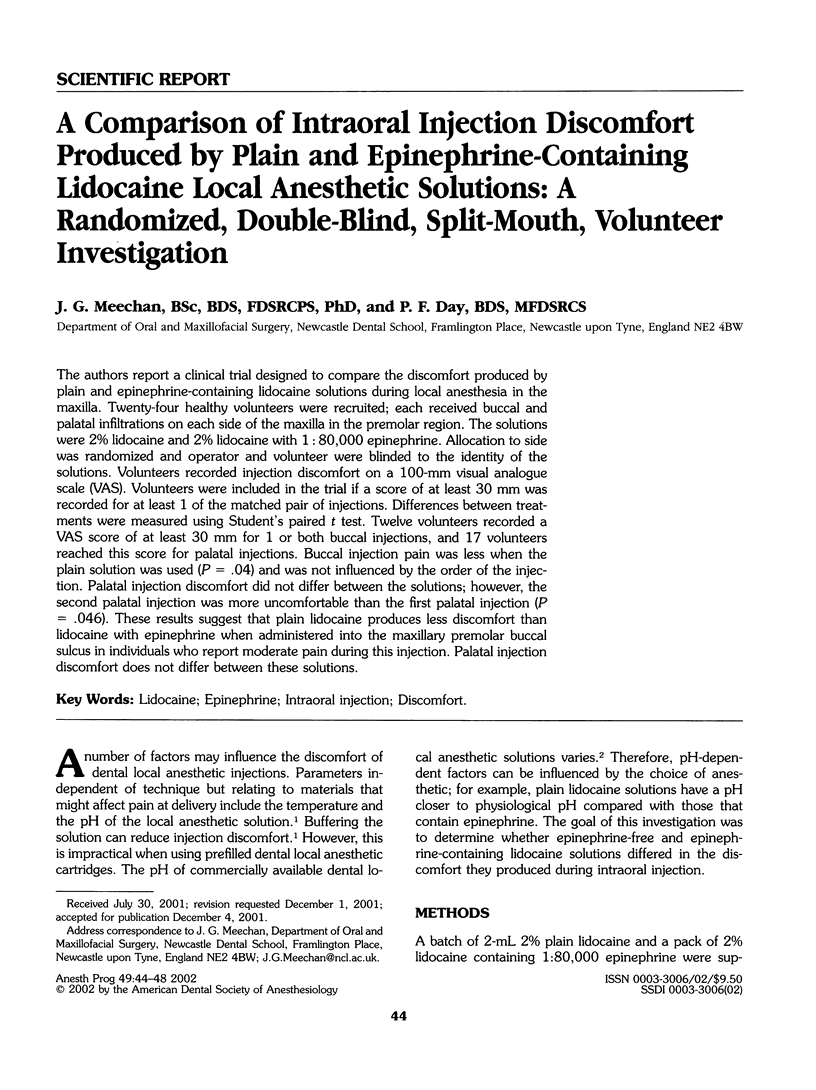
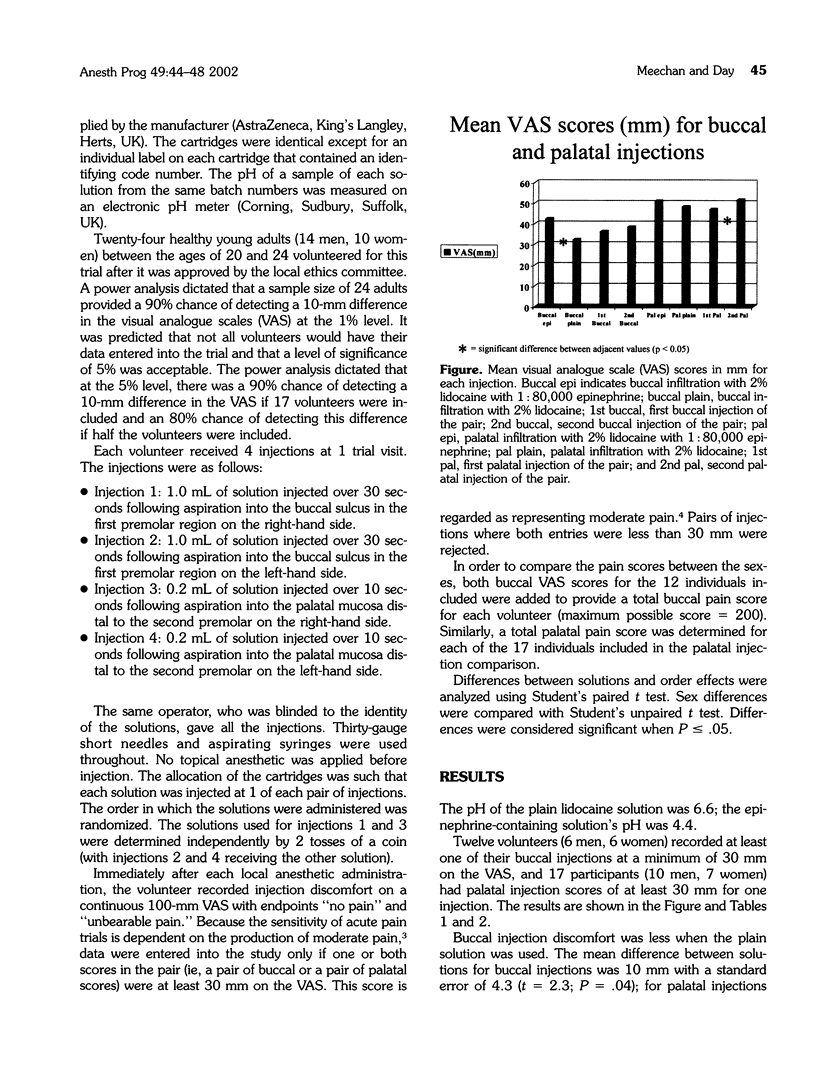
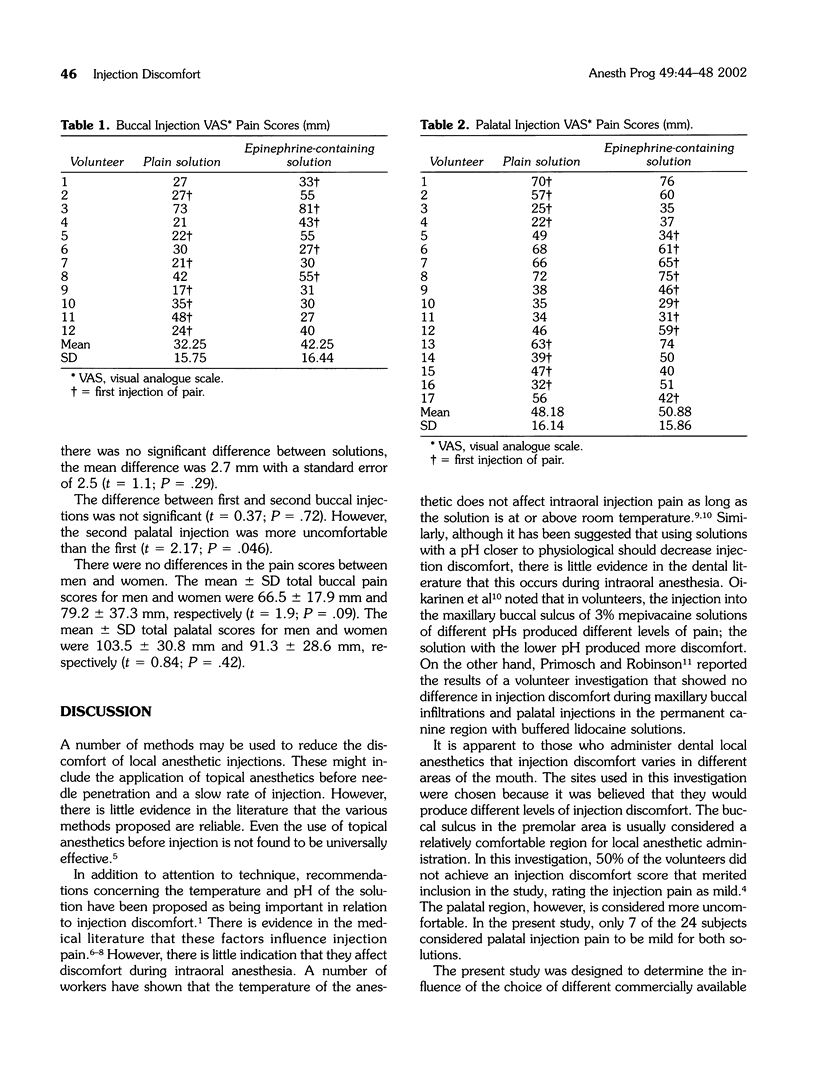
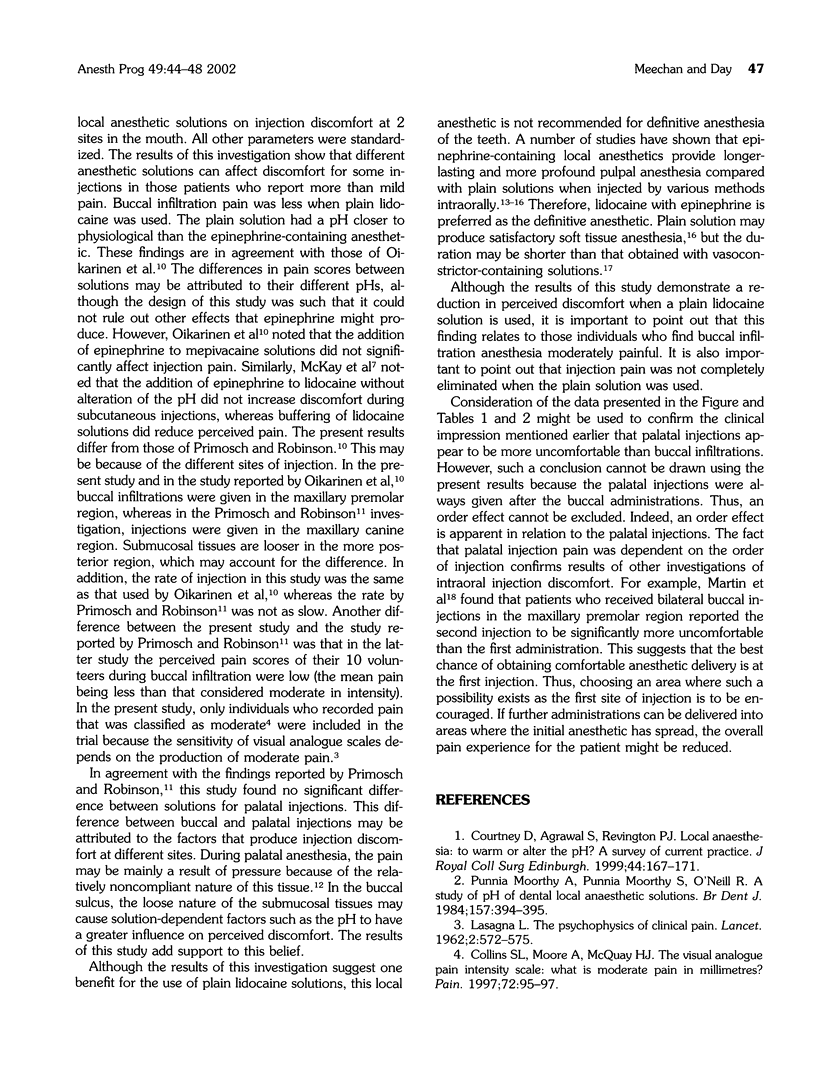
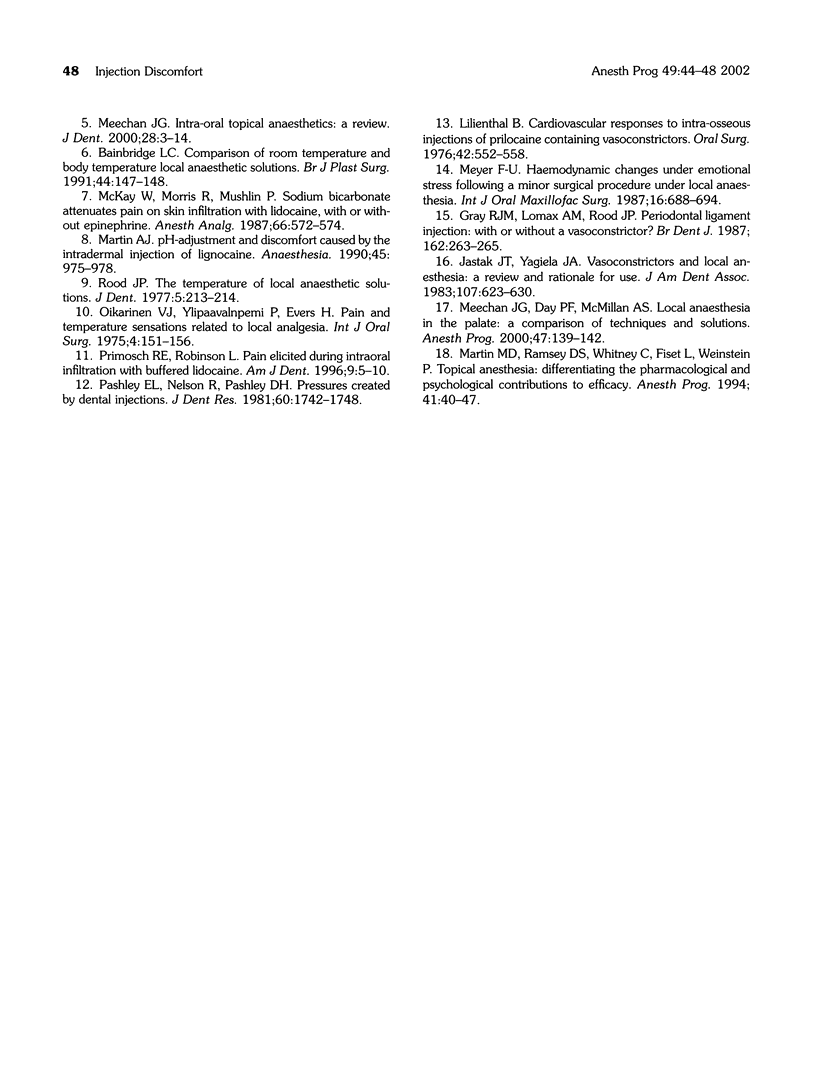
Selected References
These references are in PubMed. This may not be the complete list of references from this article.
- Bainbridge L. C. Comparison of room temperature and body temperature local anaesthetic solutions. Br J Plast Surg. 1991 Feb-Mar;44(2):147–148. doi: 10.1016/0007-1226(91)90050-t. [DOI] [PubMed] [Google Scholar]
- Collins S. L., Moore R. A., McQuay H. J. The visual analogue pain intensity scale: what is moderate pain in millimetres? Pain. 1997 Aug;72(1-2):95–97. doi: 10.1016/s0304-3959(97)00005-5. [DOI] [PubMed] [Google Scholar]
- Courtney D. J., Agrawal S., Revington P. J. Local anaesthesia: to warm or alter the pH? A survey of current practice. J R Coll Surg Edinb. 1999 Jun;44(3):167–171. [PubMed] [Google Scholar]
- Gray R. J., Lomax A. M., Rood J. P. Periodontal ligament injection: with or without a vasoconstrictor? Br Dent J. 1987 Apr 11;162(7):263–265. doi: 10.1038/sj.bdj.4806100. [DOI] [PubMed] [Google Scholar]
- Jastak J. T., Yagiela J. A. Vasoconstrictors and local anesthesia: a review and rationale for use. J Am Dent Assoc. 1983 Oct;107(4):623–630. doi: 10.14219/jada.archive.1983.0307. [DOI] [PubMed] [Google Scholar]
- LASAGNA L. The psychophysics of clinical pain. Lancet. 1962 Sep 22;2(7256):572–575. doi: 10.1016/s0140-6736(62)90445-2. [DOI] [PubMed] [Google Scholar]
- Lilienthal B. Cardiovascular responses to intraosseous injections of prilocaine containing vasoconstrictors. Oral Surg Oral Med Oral Pathol. 1976 Nov;42(5):552–558. doi: 10.1016/0030-4220(76)90203-6. [DOI] [PubMed] [Google Scholar]
- Martin A. J. pH-adjustment and discomfort caused by the intradermal injection of lignocaine. Anaesthesia. 1990 Nov;45(11):975–978. doi: 10.1111/j.1365-2044.1990.tb14636.x. [DOI] [PubMed] [Google Scholar]
- Martin M. D., Ramsay D. S., Whitney C., Fiset L., Weinstein P. Topical anesthesia: differentiating the pharmacological and psychological contributions to efficacy. Anesth Prog. 1994;41(2):40–47. [PMC free article] [PubMed] [Google Scholar]
- McKay W., Morris R., Mushlin P. Sodium bicarbonate attenuates pain on skin infiltration with lidocaine, with or without epinephrine. Anesth Analg. 1987 Jun;66(6):572–574. [PubMed] [Google Scholar]
- Meechan J. G., Day P. F., McMillan A. S. Local anesthesia in the palate: a comparison of techniques and solutions. Anesth Prog. 2000 Winter;47(4):139–142. [PMC free article] [PubMed] [Google Scholar]
- Meechan J. G. Intra-oral topical anaesthetics: a review. J Dent. 2000 Jan;28(1):3–14. doi: 10.1016/s0300-5712(99)00041-x. [DOI] [PubMed] [Google Scholar]
- Meyer F. U. Haemodynamic changes under emotional stress following a minor surgical procedure under local anaesthesia. Int J Oral Maxillofac Surg. 1987 Dec;16(6):688–694. doi: 10.1016/s0901-5027(87)80054-1. [DOI] [PubMed] [Google Scholar]
- Moorthy A. P., Moorthy S. P., O'Neil R. A study of pH of dental local anaesthetic solutions. Br Dent J. 1984 Dec 8;157(11):394–395. doi: 10.1038/sj.bdj.4805506. [DOI] [PubMed] [Google Scholar]
- Oikarinen V. J., Ylipaavalniemi P., Evers H. Pain and temperature sensations related to local analgesia. Int J Oral Surg. 1975 Sep;4(4):151–156. doi: 10.1016/s0300-9785(75)80063-9. [DOI] [PubMed] [Google Scholar]
- Pashley E. L., Nelson R., Pashley D. H. Pressures created by dental injections. J Dent Res. 1981 Oct;60(10):1742–1748. doi: 10.1177/00220345810600100301. [DOI] [PubMed] [Google Scholar]
- Primosch R. E., Robinson L. Pain elicited during intraoral infiltration with buffered lidocaine. Am J Dent. 1996 Feb;9(1):5–10. [PubMed] [Google Scholar]
- Rood J. P. The temperature of local anaesthetic solutions. J Dent. 1977 Sep;5(3):213–214. doi: 10.1016/0300-5712(77)90006-9. [DOI] [PubMed] [Google Scholar]


